Didelphis virginiana
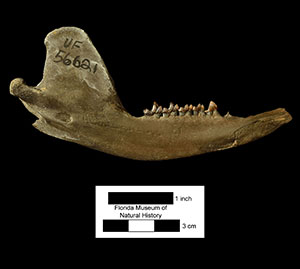
Quick Facts
Common Name: Virginia opossum, North American opossum
The family Didelphidae originated in the Cretaceous and today is most diverse in South America.
Didelphis virginiana was the last South American mammal to disperse into temperate North America during the Great American Biotic Interchange. But only it, the porcupine, and the armadillo survive today.
Age Range
- Middle Pleistocene to Holocene Epochs; late Irvingtonian to present land mammal age
- About 600,000 years ago to present
Scientific Name and Classification
Didelphis virginiana Kerr, 1792
Source of Species Name: This species is named after the state of Virginia.
Classification: Mammalia, Marsupialia, Ameridelphia, Didelphimorpha, Didelphidae, Didelphinae
Alternate Scientific Names: Didelphis pilosissima; Didelphis illinensium; Didelphis woapink; Didelphis boreoamericana
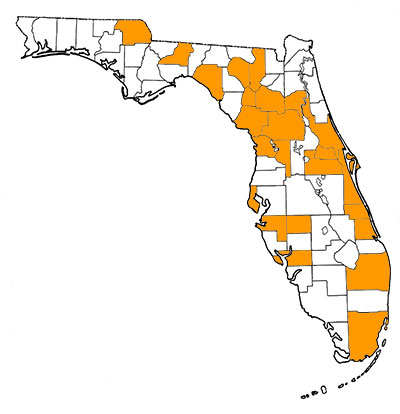
Overall Geographic Range
In addition to the Irvingtonian and Rancholabrean of Florida, fossils of Didelphis virginiana have been found in the Rancholabrean of Arkansas, Georgia, Kentucky, Louisiana, Missouri, New Mexico, Tennessee, Texas, and Virginia. They also occur in numerous archaeological sites in the Holocene of North America, where they ranged as far north as West Virginia and Northern Ohio at 1400 A.D. to 1600 A.D. In recent times, Didelphis virginiana has been known to range as far north as southern Ontario, Canada. The type locality of this species is Virginia. (Guilday, 1958; McManus, 1974; Kurtén and Anderson, 1980).
Florida Fossil Occurrences
Discussion
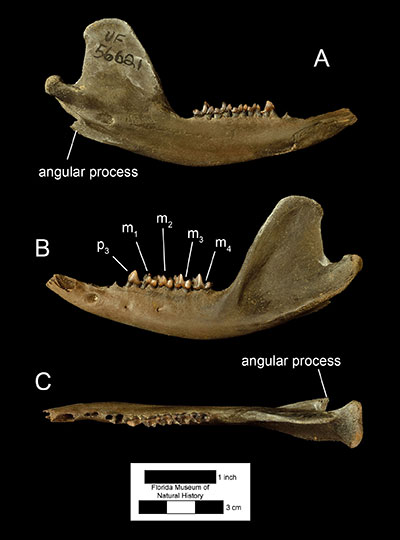
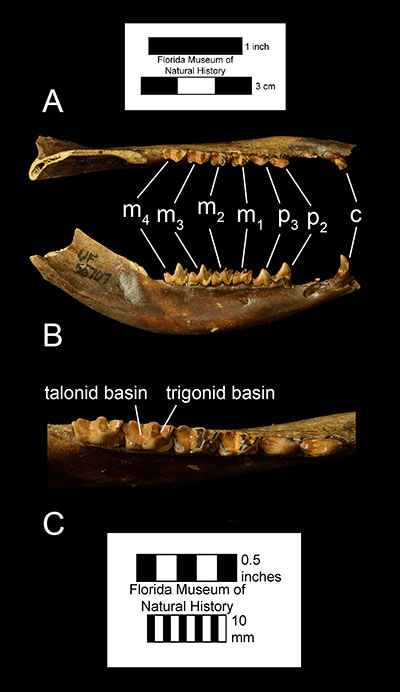
Didelphis virginiana, or the Virginia opossum, is an extant North American marsupial mammal. Like all marsupials (also known as metatherians), offspring of the Virginia opossum are born relatively early in development and are reared in the marsupium, or the marsupial pouch. This is different from placental mammals (eutherians), which do not have a marsupium and are characterized by having a placenta that nourishes the developing offspring during pregnancy. Like other species in the genusDidelphis, Didelphis virginiana has five toes per foot with a clawless and an opposable big toe (hallux). They are medium-sized mammals characterized by thick underfur, variably grayish pelage color that is lighter ventrally, and a hairless prehensile tail (Gardner, 1973). Males are about 2.8 kg or 6.2 lbs. in weight and the females are lighter, at around 1.9 kg or 4.2 lbs. (McManus, 1974). They differ from a closely related species Didelphis marsupialis from the neotropics of Central America in being able to tolerate cooler climates (Gardner, 1973). More information on the modern species may be found at the Animal Diveristy Web.
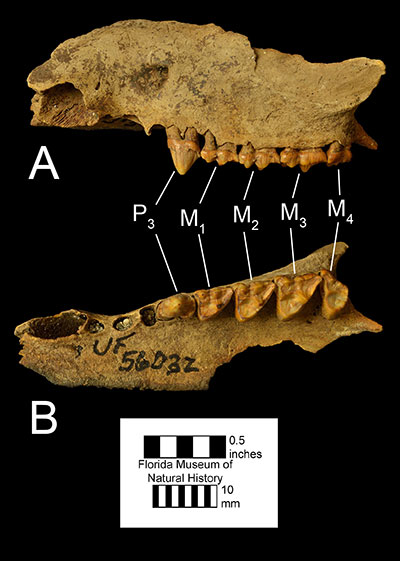
Didelphis virginiana is in Didelphidae, a marsupial family that was confined to South America in distribution until the Plio-Pleistocene due to the isolation of that continent through much of the Cenozoic Era (Szalay, 1994). In the late Pliocene (approximately 3 million years ago), North and South America became connected through the formation of a land bridge at the Isthmus of Panama (Morgan, 2004). It is thought that this facilitated the movement of animals from South America to North America and vice versa, resulting in changes in faunal composition of the two continents that is known as the Great American Biotic Interchange (GABI; Stehli and Webb, 1985). While the genus Didelphis is known from South American Pliocene sites, it appears to have been absent from North and Central America until the late Pleistocene epoch, some 0.8 to 1 million years ago (Gardner, 1973). In fact, Didelphis is the last mammalian genus to arrive in temperate North America as a result of the GABI, and is only one of three genera (along with the armadillo, Dasypus and the porcupine, Erethizon) that arrived from South America during the interchange that is still found in North America (Morgan, 2004). The earliest fossil referred to Didelphis is from the middle Irvingtonian of Texas, but the first records of Didelphis virginiana comes from the late Irvingtonian Coleman 2A and the Sebastian Canal local fauna in Florida, approximately 600,000 years ago. All other known fossils of Dideplphis virginiana come from the Rancholabrean or later, primarily in Florida and the Southeastern United States, where they survived through to the present day (Hulbert, 2001; Morgan, 2004). While there have been no fossils of Didelphis found in Central America predating these fossils from the late Pleistocene (Morgan, 2004), it has been hypothesized that Didelphis virginiana evolved from the Central American species Didelphis marsupialis earlier in the Pleistocene and dispersed to temperate North America due to their ability to live in colder climates (Gardner, 1973).
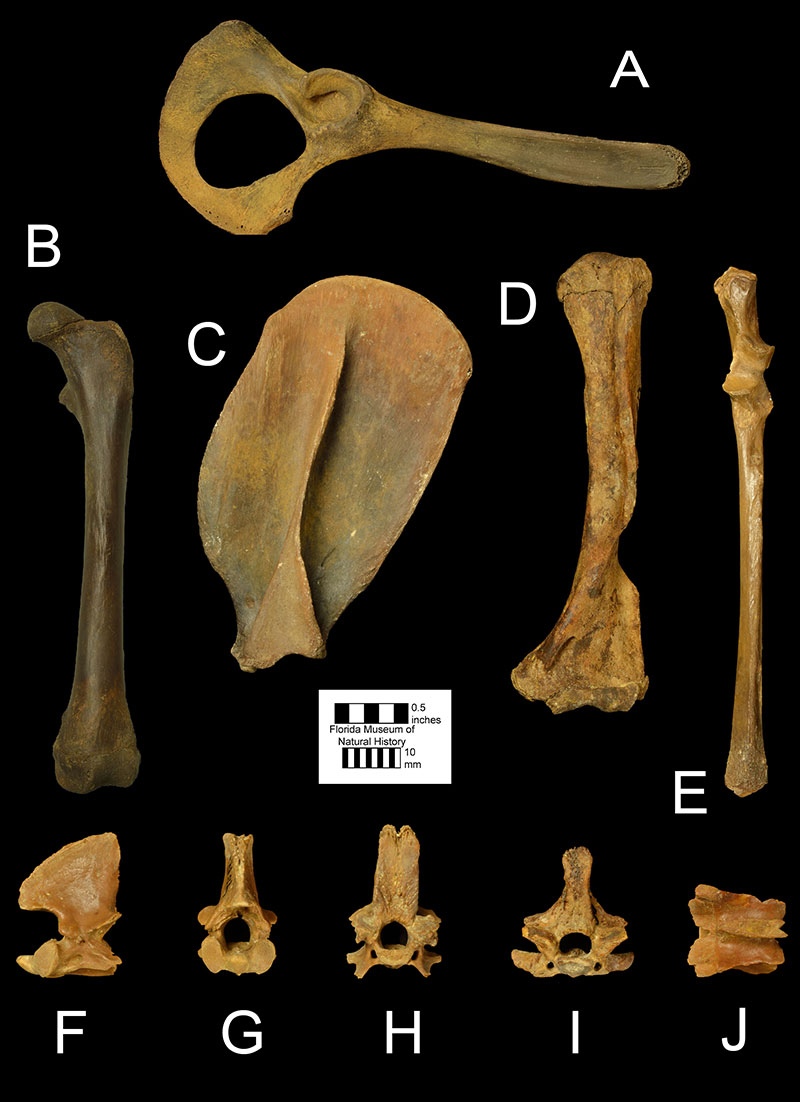
Sources
- Original Author(s): Arianna Harrington
- Original Completion Date: April 28, 2015
- Editor(s) Name(s): Richard C. Hulbert, Jr., Natali Valdes
- Last Updated On: May 12, 2015
This material is based upon work supported by the National Science Foundation under Grant Number CSBR 1203222, Jonathan Bloch, Principal Investigator. Any opinions, findings, and conclusions or recommendations expressed in this material are those of the author(s) and do not necessarily reflect the views of the National Science Foundation.
Copyright © Florida Museum of Natural History, University of Florida